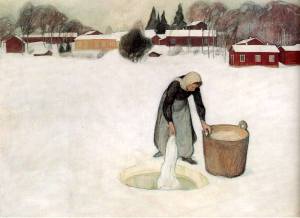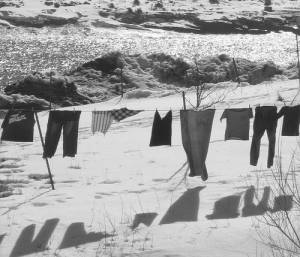-
History of:
- Resources about:
- More:
- Baby walkers
- Bakehouses
- Bed warmers
- Beer, ale mullers
- Besoms, broom-making
- Box, cabinet, and press beds
- Butter crocks, coolers
- Candle snuffers, tallow
- Clothes horses, airers
- Cooking on a peat fire
- Drying grounds
- Enamel cookware
- Fireplaces
- Irons for frills & ruffles
- Knitting sheaths, belts
- Laundry starch
- Log cabin beds
- Lye and chamber-lye
- Mangles
- Marseilles quilts
- Medieval beds
- Rag rugs
- Rushlights, dips & nips
- Straw mattresses
- Sugar cutters - nips & tongs
- Tablecloths
- Tinderboxes
- Washing bats and beetles
- Washing dollies
- List of all articles
Subscribe to RSS feed or get email updates.
We noticed, yesterday, when some women were washing, where the ice was broken in the river, that the steam rose just as if they had been using boiling water; this was occasioned by the condensation of vapor .......
St. Petersburg, Russia, 1818, described by William Allen, 2000
I see my mother coming up from the shore carrying firewood on her shoulders and also lugging two large wooden buckets full of laundry that she has rinsed in an ice hole of the cold river, and she hangs the laundry on the line outside. Her felt boots are covered with a thick layer of snow.
Natalja Markus describing life in 1955 for the German community in Siberia
Laundry in ice and snow
Washing in a frozen river
 This painting of the artist's sister,
Lyydi Halonen, doing laundry through an ice hole in Finland in 1900 reminds us how
difficult housekeeping without electricity can be.
Washing at the riverside in summer weather may seem pleasant enough despite
the hard work involved, but what happens if you live somewhere with long, cold winters?
This painting of the artist's sister,
Lyydi Halonen, doing laundry through an ice hole in Finland in 1900 reminds us how
difficult housekeeping without electricity can be.
Washing at the riverside in summer weather may seem pleasant enough despite
the hard work involved, but what happens if you live somewhere with long, cold winters?
After you've chopped through the ice with an axe, vapour will rise from the "warm" water and be visible for a while in the cold air. You must lean over the hole to swish your linen around in clean water. You will probably have soaped and scrubbed dirty things indoors before venturing out to rinse them. Ice-hole laundry has been part of winter life in many places, and still continues in some: parts of rural Russia, for example.
City washerwomen too used to do laundry in ice holes. English-speaking visitors to St. Petersburg in Russia during the 19th century often wrote of their astonishment at seeing groups of women working round holes in the frozen River Neva for hours at a time. They seem to have been quite well-organised. An ice-breaker was employed to prepare the hole, and screens were arranged to protect the washerwomen from chilling winds. Writers describe them singing, chatting, and joking.
The washing of clothes at Petersburgh is very remarkable; it is done by women, who stand for hours on the ice, plunging their bare arms into the freezing water, in, perhaps, eighteen or twenty degrees of frost. They shelter themselves from the wind, which is the most bitter part of winter—fifteen degrees of frost, with wind, being more severe than twenty-five or thirty without—by means of large fir branches stuck in the ice, on which they hang mats. In general the women seem to be more regardless of cold than the men ; they seldom, even in the most intense cold, wear any thing on their heads but a silk handker-chief.
R. and A. Heber, The Life of Reginald Heber, 1830
 Hauling
water from an ice-hole to an indoor washtub is hard work, but surely better than
washing outside in sub-zero temperatures. But it doesn't solve the problem of
getting clothes and bed-linen dry. If you have a clothes-line it's easy to get
fabric to a "just damp" stage in suitable weather, even when the ground
is covered in snow. The alternative is indoor drying on some kind of rack or
clothes horse - very inconvenient if you have a lot of laundry in a small
home.
Hauling
water from an ice-hole to an indoor washtub is hard work, but surely better than
washing outside in sub-zero temperatures. But it doesn't solve the problem of
getting clothes and bed-linen dry. If you have a clothes-line it's easy to get
fabric to a "just damp" stage in suitable weather, even when the ground
is covered in snow. The alternative is indoor drying on some kind of rack or
clothes horse - very inconvenient if you have a lot of laundry in a small
home.
...underwear, linen sheets, tablecloths, and the like had to be washed in the river nearly a mile away, even in the wintry months when the washing had to be done through a hole in the ice.
1920s Poland, memories collected by Sydney Stahl Weinberg in The World of Our Mothers: The Lives of Jewish Immigrant Women, 1988
 24 February 2009
24 February 2009
See also: Washing in the river
History of Laundry in the 1800s
Other laundry articles on this site
You may like our new sister site Home Things Past where you'll find articles about antiques, vintage kitchen stuff, crafts, and other things to do with home life in the past. There's space for comments and discussion too. Please do take a look and add your thoughts. (Comments don't appear instantly.)
For sources please refer to the books page, and/or the excerpts quoted on the pages of this website, and note that many links lead to museum sites. Feel free to ask if you're looking for a specific reference - feedback is always welcome anyway. Unfortunately, it's not possible to help you with queries about prices or valuation.


